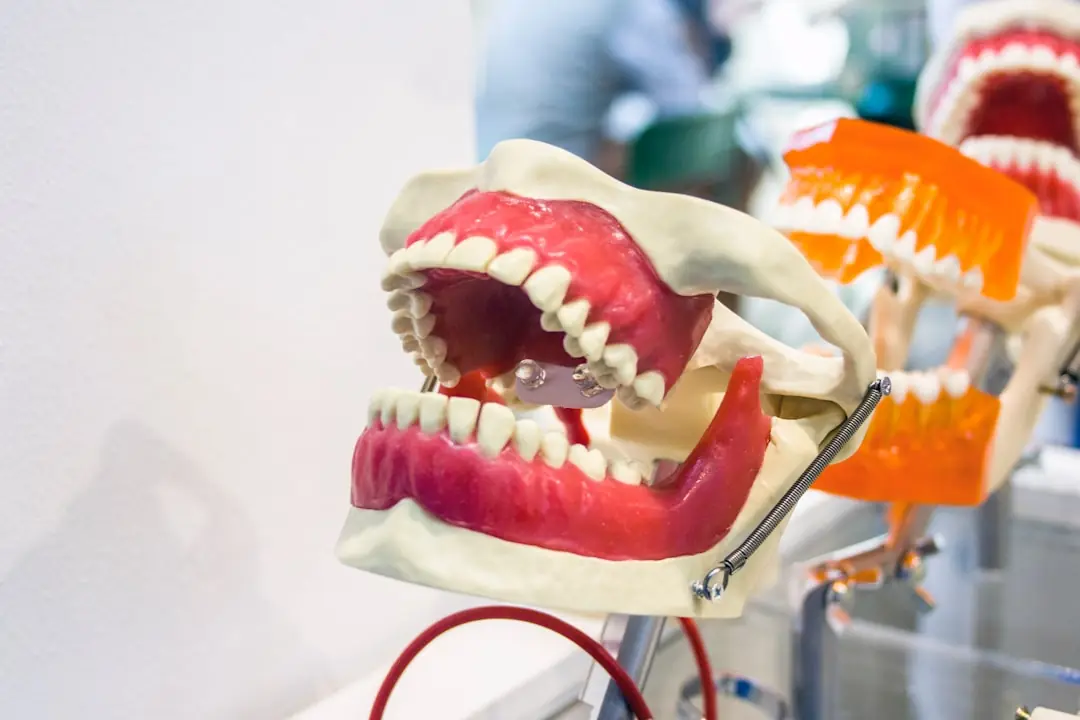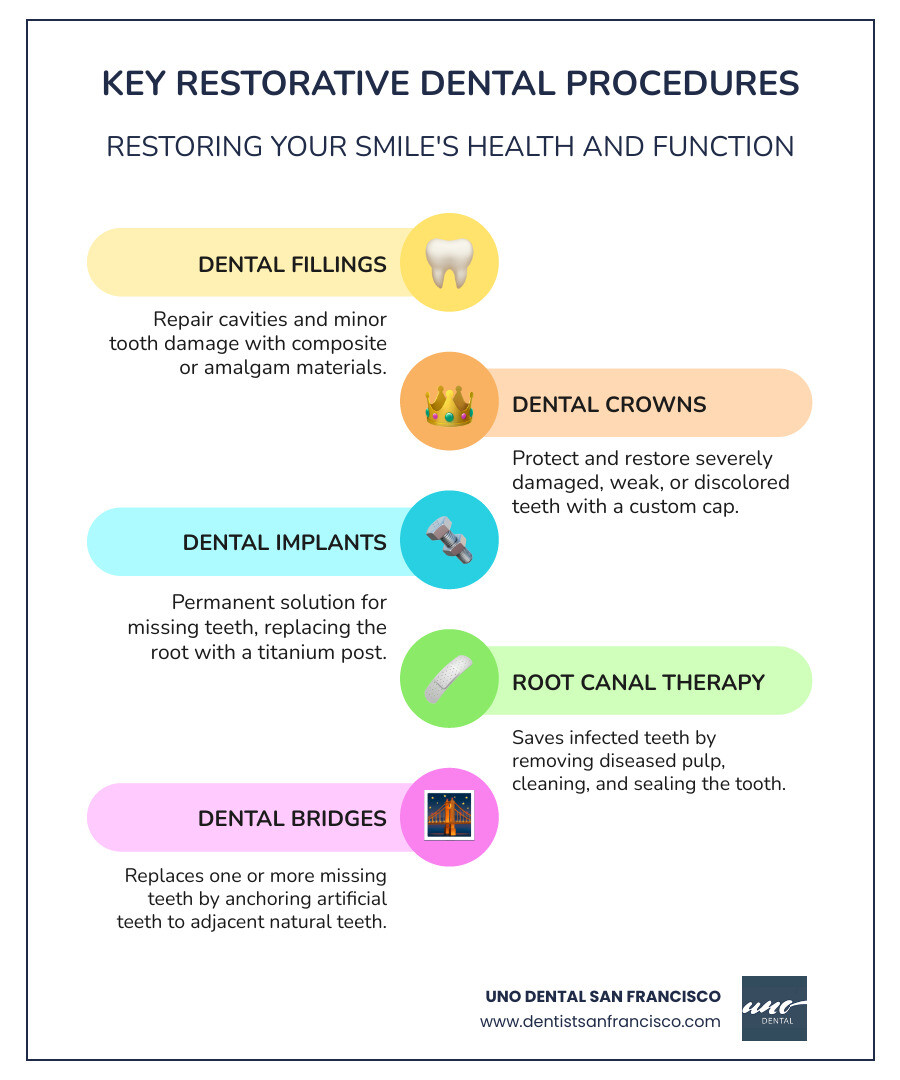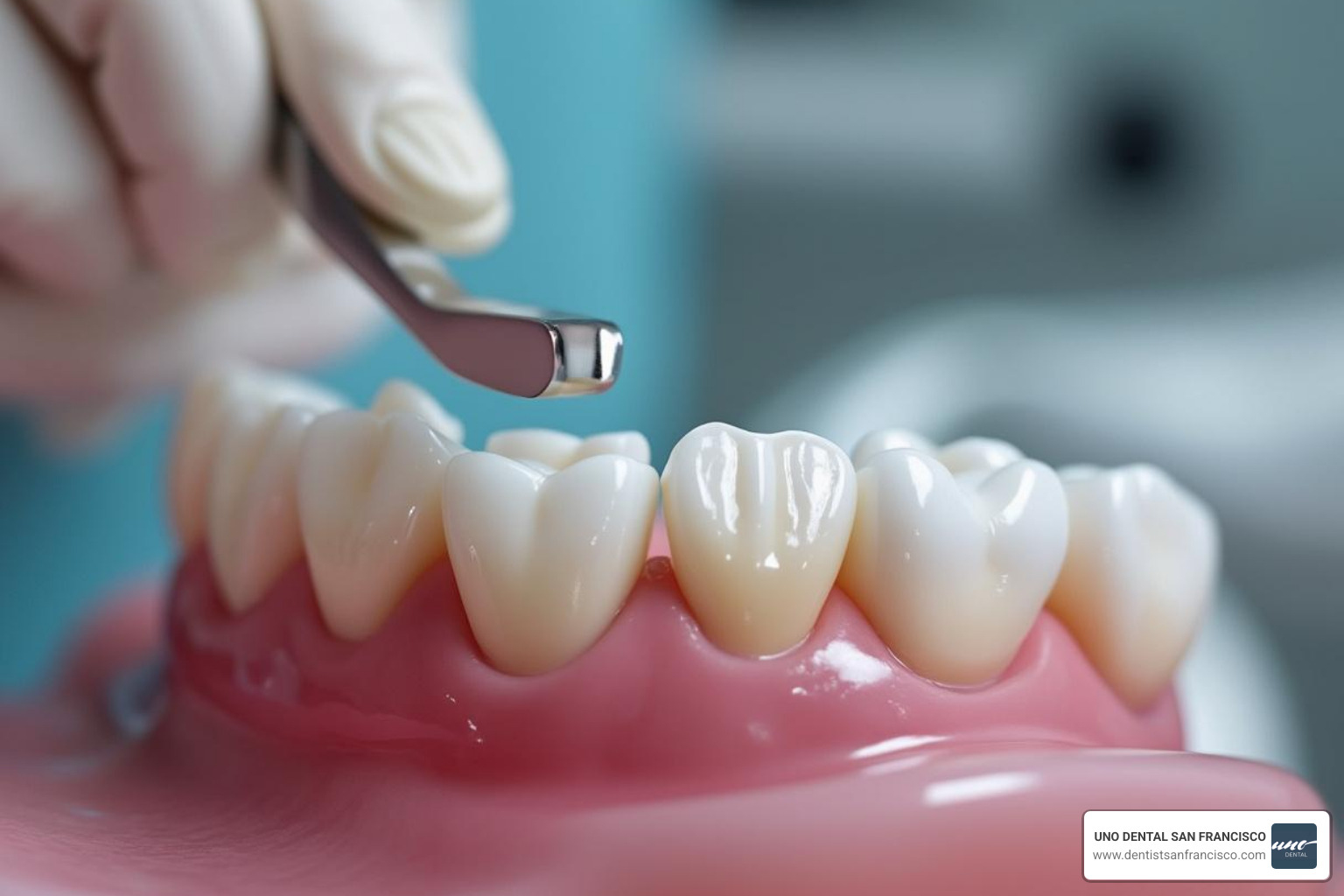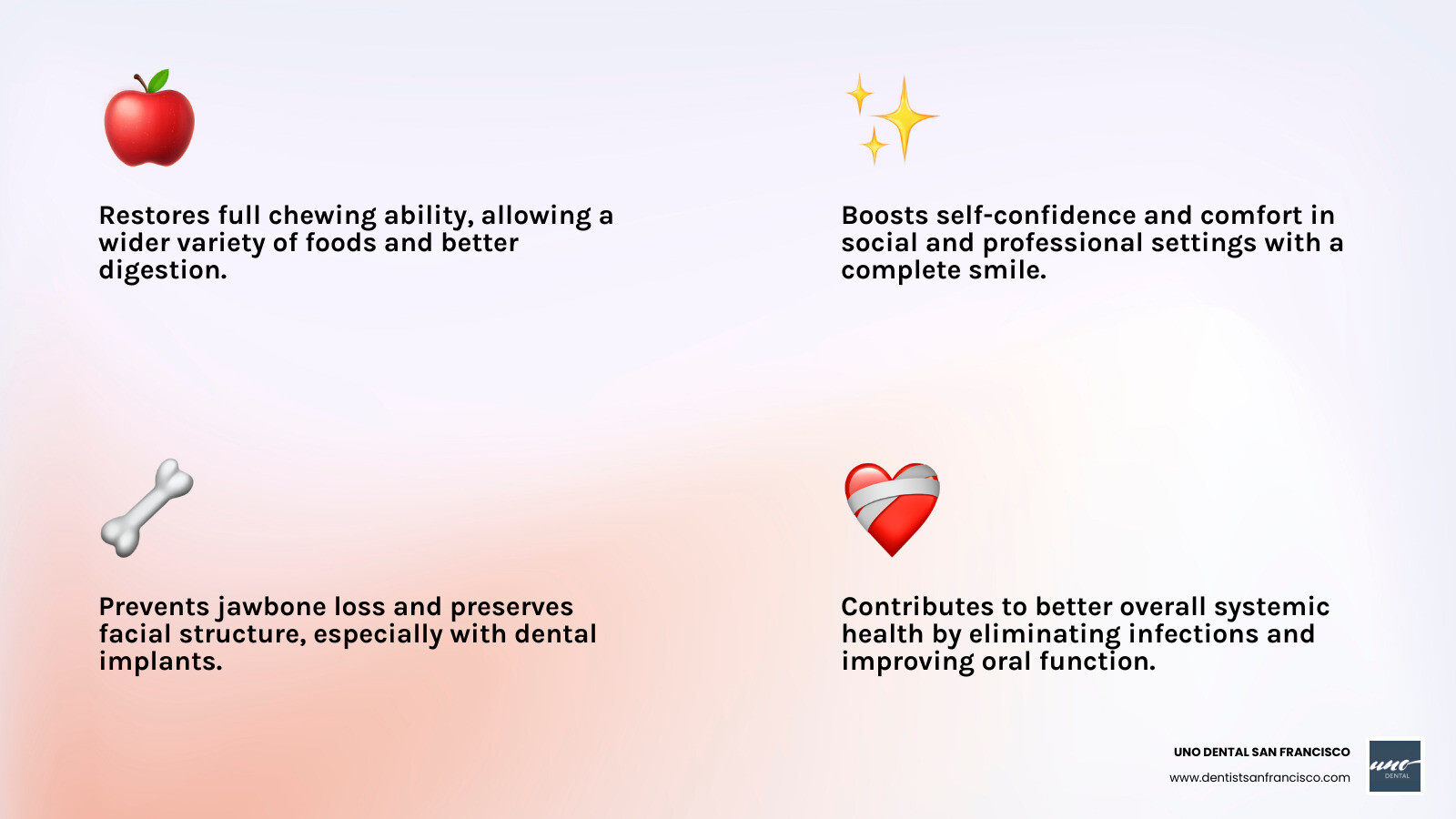
Showing Restorative Dentistry: A Guide to Restoring Your Smile
What services does restorative dentistry include? Restorative dentistry is a key area of dental care focused on repairing damaged teeth and replacing missing ones. Its main goal is to bring back the normal look, feel, and function of your smile. This helps you chew, speak, and smile with confidence.
Restorative dentistry commonly includes these services:
- Dental Fillings
- Dental Crowns
- Dental Bridges
- Dentures (full, partial, and implant-supported)
- Dental Implants
- Root Canal Therapy
- Inlays and Onlays
- Scaling and Root Planing (Periodontal Therapy)
With 15 years of experience in advanced dentistry, I specialize in creating custom treatment plans that integrate restorative, cosmetic, and prosthodontic solutions to meet each patient's unique needs.
Find more about what services does restorative dentistry include:
What is Restorative Dentistry and Why is it Important?
When teeth are damaged or missing, it affects more than just your appearance—it impacts your ability to eat, speak, and your overall health. Restorative dentistry steps in to bring harmony back to your oral health.
Restorative dentistry is a field dedicated to repairing or replacing teeth to improve oral health and chewing function. It brings back the normal look and feel of your smile. Common issues like cavities or tooth damage, if ignored, can lead to bigger problems like decay, gum disease, and tooth loss. Addressing these concerns early prevents future complications and more expensive treatments.
The Primary Goal: Restoring Health and Function
The main goal is to restore your smile's health, function, and appearance. We aim to save natural teeth, correct bite alignment for comfortable chewing, and prevent surrounding teeth from shifting into empty spaces left by missing teeth. Restorative treatments like dental implants also help prevent jawbone loss (bone resorption) that occurs when a tooth is lost.
Restorative treatments help us achieve lasting oral health and boost your confidence. Being able to properly chew your food, speak clearly, and smile without any self-consciousness significantly improves your daily life and overall well-being.
For a general overview of restorative care, you can refer to An overview of restorative care from the Mayo Clinic.
Who is a Candidate for Restorative Dentistry?
You may be a candidate for restorative dentistry if you have damaged, decayed, or missing teeth, including issues like:
- Cavities or Tooth Decay: The most common reason for restorative treatment, caused by bacteria eroding tooth enamel.
- Cracked or Broken Teeth: Often resulting from injury, teeth grinding, or large old fillings.
- Missing One or More Teeth: Due to decay, gum disease, or an accident.
- Worn-Down Teeth: Caused by grinding (bruxism), acid erosion, or natural aging.
- Infected Teeth: Often requiring root canal therapy to save the tooth.
- Gum Disease: Severe cases can lead to tooth loss if left untreated.
If you find yourself in any of these situations, restorative dentistry offers proven solutions to bring your smile back to its prime.
What Services Does Restorative Dentistry Include? A Comprehensive Breakdown
What services does restorative dentistry include? This varied field is a toolkit for repairing and replacing teeth to restore your smile's health and beauty. Procedures can be direct restorations, completed in the mouth (like fillings), or indirect restorations, custom-made in a lab (like crowns). At UNO DENTAL, we use advanced, patient-centered techniques to create a treatment plan that fits you perfectly.
Dental Fillings: The First Line of Defense
Dental fillings are the first line of defense against tooth decay. We remove the decayed portion of the tooth and fill the space with a durable material. While silver (amalgam) fillings were once common, we prefer tooth-colored composite fillings. Made from a resin and ceramic mix, they bond directly to your tooth, blend in seamlessly, and preserve more healthy tooth structure. With proper care, fillings can last from 5 to 15 years.
Ready to make cavity repair a breeze? Learn more about our Dental Fillings services.
Dental Crowns & Bridges: Rebuilding and Replacing Teeth
When a tooth is too damaged for a filling or is missing, we use dental crowns and bridges. A dental crown is a custom-made cap that covers a damaged tooth to restore its shape, size, and strength. We use them for large cavities, fractures, or after a root canal. Natural-looking porcelain and ceramic options mimic your natural teeth.
A dental bridge replaces one or more missing teeth by anchoring artificial teeth to adjacent natural teeth or dental implants. Bridges restore chewing function and prevent other teeth from shifting. Both are excellent ways to rebuild your smile.
Find more about our Dental Crowns services and Dental Bridges services.
Inlays and Onlays: The "In-Between" Solution
For damage too extensive for a filling but not requiring a full crown, inlays and onlays are the ideal solution. These custom-made restorations, often called partial crowns, are crafted in a lab and bonded to the tooth. An inlay fits within the cusps (bumps) on the tooth's chewing surface, while an onlay covers one or more cusps. Made from durable porcelain or gold, they conserve more natural tooth structure than a full crown while offering superior strength to a filling.
Root Canal Therapy: Saving a Severely Damaged Tooth
When infection from a deep cavity or crack reaches the tooth's inner pulp (nerves and blood vessels), it can cause significant pain and swelling. Root canal therapy can save the tooth. In this endodontic procedure, we remove the infected pulp, then clean, disinfect, and seal the root canal. This eliminates the infection and pain, allowing you to keep your natural tooth. A dental crown is often placed afterward to restore the tooth's strength and function.
To understand more about how we can save your tooth, check out our page on Root Canal Therapy services.
Dental Implants: The Gold Standard for Tooth Replacement
Dental implants are the gold standard for replacing missing teeth, offering a permanent, stable, and natural-feeling solution. An implant is a small titanium post surgically placed in the jawbone, where it acts as a new tooth root. The bone fuses with the post through a process called osseointegration, creating a strong foundation. We then attach a connector (abutment) and a custom crown. The result looks and functions like a natural tooth. Key benefits include preventing jawbone loss, protecting your bite, and preserving adjacent healthy teeth. Care is simple: just brush, floss, and attend regular check-ups.
For a deeper dive into this transformative treatment, explore our Dental Implants services and check out An informative page from the American College of Prosthodontists.
Dentures: Versatile Solutions for Missing Teeth
For those missing multiple teeth or a full arch, modern dentures are an effective solution for restoring your smile and chewing ability. They are custom-made to look natural and fit comfortably. We offer several types:
- Full Dentures: Replace all teeth in an upper or lower jaw, resting on the gums.
- Partial Dentures: Replace one or more missing teeth, attaching to remaining natural teeth with clasps.
- Implant-Supported Dentures: Combine dentures with dental implants for superior stability, comfort, and chewing power. These dentures attach securely to implants, which also helps prevent jawbone loss.
Dentures can significantly improve your quality of life. To learn more about which option might be right for you, visit our Dentures services.
Periodontal Therapy: Restoring Gum Health
Periodontal therapy is a vital part of restorative dentistry because healthy gums are the foundation for healthy teeth. Gum disease, an infection of the tissues supporting your teeth, can lead to tooth loss if untreated. The most common treatment is scaling and root planing, or a "deep cleaning." This procedure removes plaque and tartar from above and below the gum line and smooths the tooth roots to eliminate bacteria. This therapeutic cleaning treats active gum disease, helping restore gum health and preventing the disease from progressing.
Restorative vs. Cosmetic Dentistry: Understanding the Difference
Restorative and cosmetic dentistry often overlap. Restorative dentistry focuses on health and function, while cosmetic dentistry focuses on appearance. However, many procedures achieve both goals simultaneously.
The primary differences are:
| Feature | Restorative Dentistry | Cosmetic Dentistry |
|---|---|---|
| Primary Goal | To restore function, health, and structural integrity. | To improve the aesthetic appearance of teeth and smile. |
| Main Focus | Repairing damage, replacing missing teeth, alleviating pain. | Enhancing smile aesthetics, symmetry, and brightness. |
| Typical Procedures | Fillings, crowns, bridges, implants, root canals, dentures, periodontal therapy. | Teeth whitening, veneers, cosmetic bonding, gum reshaping. |
| Insurance Coverage | Often covered, especially if medically necessary for function. | Less frequently covered, often considered elective. |
While their primary goals differ, the missions of restorative and cosmetic dentistry often coincide. This allows us to provide holistic treatments that address both health and aesthetic goals.
What services does restorative dentistry include that are also cosmetic?
Many restorative procedures also offer significant cosmetic benefits:
- Tooth-colored fillings repair cavities while blending seamlessly with your natural tooth, offering a significant aesthetic improvement over old silver fillings.
- Porcelain crowns protect damaged teeth while being custom-made to match the color and shape of your natural teeth for a beautiful, functional result.
- Dental implants restore chewing function and prevent bone loss, while the final crown is designed to look just like a natural tooth, creating a flawless smile.
- Dental bridges restore chewing ability and prevent teeth from shifting, which also significantly improves your smile's appearance.
These procedures clearly demonstrate how what services does restorative dentistry include can simultaneously protect your oral health and dramatically improve your smile's appeal.
When is a procedure considered purely cosmetic?
Procedures considered purely cosmetic focus primarily on aesthetics rather than health or function:
- Teeth whitening brightens teeth discolored by staining or aging.
- Veneers are thin, custom shells bonded to the front of teeth to improve their shape, color, or size, correcting issues like chips or gaps.
- Cosmetic bonding uses tooth-colored resin to repair minor chips, cracks, or gaps for aesthetic improvement.
- Gum reshaping corrects an uneven gum line or a "gummy" smile for a more balanced appearance.
At UNO DENTAL SAN FRANCISCO, we practice holistic smile design, understanding that a beautiful smile is also healthy and functional. We work with you to find the best approach for your needs, ensuring your smile is both strong and stunning.
The Overall Benefits of Restorative Dental Treatment
Restorative dental treatment is an investment in your overall well-being, bringing back your smile's full potential. The benefits include:
Restorative treatments lead to improved chewing ability, allowing you to enjoy your favorite foods and aiding digestion. You may also notice clearer speech as it becomes easier to form sounds. This allows you to talk and laugh freely without discomfort.
A healthy, complete smile can transform how you feel about yourself, leading to improved self-confidence. A confident smile can brighten your day and open up new possibilities in social and professional settings.
Restorative dentistry offers crucial long-term advantages. Procedures like dental implants help with the prevention of jawbone loss, which preserves your facial structure. Addressing issues early also means a reduced risk of future dental problems, like spreading infections or shifting teeth. This proactive care often leads to long-term cost savings by avoiding more complex and expensive treatments later.
These benefits lead to better overall health and an improved quality of life. Your oral health is deeply connected to your general health. By eliminating infections and restoring function, restorative dentistry empowers you to eat, speak, and smile with confidence, helping you live life to the fullest.
Frequently Asked Questions about Restorative Dentistry
We know you might have a few questions, so let's tackle some of the most common ones about restorative dentistry.
How long do dental restorations last?
The lifespan of a dental restoration depends on the type of restoration, the material used, and your oral hygiene habits. With proper care, here's a general guide:
- Fillings: Composite fillings typically last 5 to 15 years.
- Crowns: Dental crowns can last 10 to 20 years or more.
- Implants: The titanium implant post can last a lifetime, while the crown on top may need replacement after 10-15 years due to normal wear.
Excellent daily brushing, flossing, and regular check-ups at UNO DENTAL are key to maximizing the longevity of your restorations.
Does dental insurance cover restorative procedures?
Most dental insurance plans offer some coverage for restorative procedures, especially when they are medically necessary to restore function and health. Coverage for fillings, crowns, and root canals is common. However, the amount of coverage varies depending on your specific plan, including deductibles and annual maximums. Purely cosmetic procedures like teeth whitening are rarely covered.
Our team at UNO DENTAL is happy to help you understand your benefits, assist with pre-authorizations, and discuss flexible payment plans to ensure you receive the care you need without financial stress.
What should I expect during a restorative dentistry consultation?
Your consultation at UNO DENTAL is a patient-centered experience focused on your goals. You can expect:
- Comprehensive Exam: A thorough examination of your teeth, gums, and overall oral health.
- Advanced Imaging: We use digital X-rays and 3D imaging for precise diagnosis and treatment planning.
- Goal Discussion: We'll listen to your concerns and what you want to achieve with your smile.
- Treatment Options: We'll explain all viable options, including their pros, cons, and costs.
- Personalized Plan: Together, we'll create a custom treatment plan that fits your needs and budget.
We also offer free virtual smile consultations, allowing you to explore your options from home before visiting our San Francisco office.
Restore Your Smile and Health in San Francisco
What services does restorative dentistry include? As we've explored, this field offers a wide range of solutions, from fillings to implants, to restore your smile's health, function, and beauty. Addressing dental issues early is crucial to prevent them from becoming more serious and costly problems.
At UNO DENTAL in San Francisco, our holistic and patient-centered care philosophy means we see the whole person, not just a set of teeth. Our UNO DENTAL SAN FRANCISCO approach blends advanced technology, like 3D imaging, with genuine, personalized care. We provide comprehensive restorative services under one roof, so you work with one dedicated team from start to finish.
A healthy, beautiful smile boosts your confidence and quality of life. It's about eating, speaking, and laughing with ease. That's the kind of smile we are passionate about creating for our San Francisco community.
Ready to see what restorative dentistry can do for you? Your journey to optimal oral health starts here. Explore our comprehensive restorative services today!




